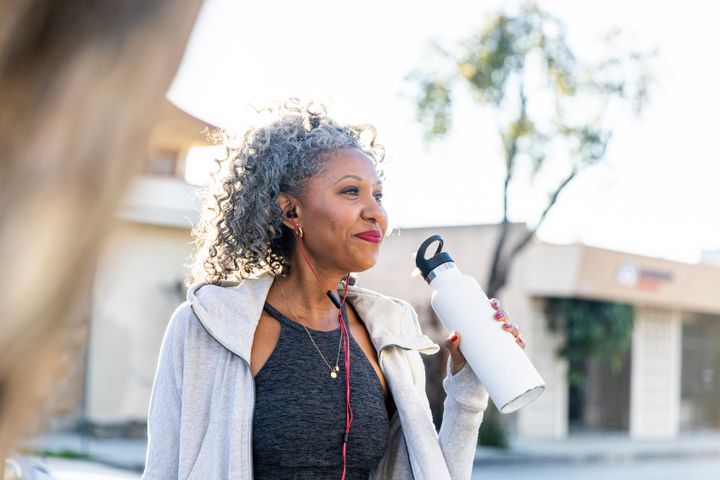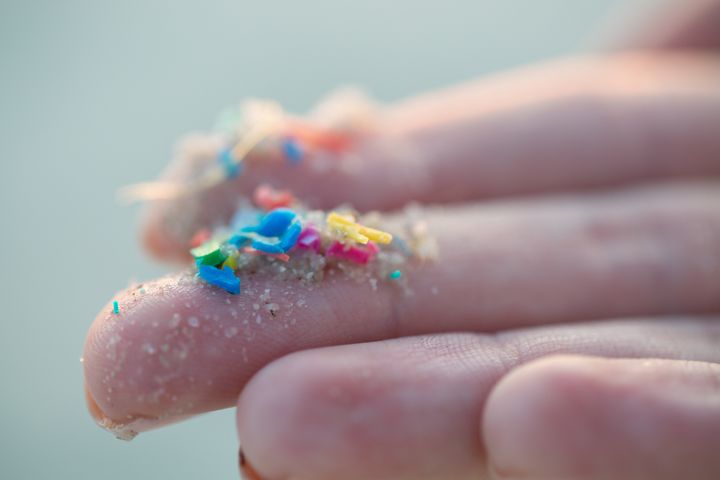
For many people, microplastics and nanoplastics (tiny plastic particles that come from larger and commercial plastics) are terrifying. It seems like news about their harmful effects comes out weekly, along with warnings about the chemicals these plastics emit. Athletic wear, plastic takeout containers and even cutting boards are just some of the items in our everyday lives that contain microplastics.
It’s only natural to want to limit your exposure to these products, especially since the unfortunate reality is that most people have some level of microplastic in their system, according to Jamie Alan, associate professor in the department of pharmacology and toxicology at Michigan State University. Research is being conducted to understand the full effect of microplastics, but they’ve been found in the plaque in our arteries, in placentas, in our blood and more.
Studies have also looked at the effect that microplastics have on our cells and organoids, Alan told HuffPost. Research shows that when microplastics get into our cells it can lead to cell death, she said. Additionally, they can attack our DNA and cause unwanted DNA changes, Alan explained.
“You can get a [DNA] change that causes zero effects, but you can get a change that can cause effects,” Alan said. This sounds scary ― and it is scary ― but it doesn’t mean you should totally panic. Our body is trained to handle these kinds of changes, she noted. However, there can be adverse effects — most notably cancer and fertility issues.
All in all, this is obviously very concerning, especially given the sheer prevalence of microplastics. While you can’t totally avoid them — they’re in our air and in our water, too — you can make some choices that limit your interactions with microplastics. Here’s what experts say you can do:
Watch how much ocean-caught fish you’re eating.
Microplastics often come from food, Alan said. “If you think about fish and things like that, there’s a lot of microplastics in our oceans, and the fish are eating these, and when we consume the fish, we’re consuming microplastics from them,” Alan said.
What’s more, microplastics are thought to be carriers of heavy metals and other elements. “And we worry about mercury and things like that in fish,” but elements such as chlorine have also been found in microplastics, Alan said.
As a result, reducing the amount of ocean-caught fish you eat can decrease the amount of microplastics you consume this way, along with other chemicals you likely don’t want in your system, she noted.
But know that seafood isn’t the only food culprit.
Shrimp and wild fish are known to contain high amounts of microplastics, but foods like chicken nuggets, plant-based nuggets, sirloin steak and other non-seafood proteins also contain microplastics.
If this feels like a lose-lose situation, you aren’t wrong. We’re told to eat fish and follow a Mediterranean diet for the sake of our health, but the fish at the center of such a diet can be full of microplastics. Sigh.
So what can you do? Alan said you can be mindful of the food you’re eating and be aware of the items that are known to contain higher amounts of microplastics than others.
Though microplastics are prevalent in a lot of our foods, chicken breast, pork loin chop and tofu have less.

Consider your clothing materials.
A major source of nanoplastics in our waterways and airways is our clothing, according to Kizzy Charles-Guzman, CEO of the Center for Environmental Health, who added that “about 70% of all our clothing is made from plastic materials.”
This includes nylon, polyester, acrylic and synthetic fibers — anything that is not a natural fiber like wool, cotton and linen, she said.
“When these textiles are manufactured, when you wash them in your laundry, when you wear them, when you dry them, they are releasing tiny plastic fibers into the water and into the air,” Charles-Guzman explained.
“So clothing, bedding, any other textiles that are not natural materials, they shed microplastics in fiber form,” she said. “And then they’re just carried off into the environment ... either by air or water.”
These microplastics are too small to be filtered in wastewater treatment plants, so they end up in our waterways, she noted.
“The reason this is important is that that’s why you’re seeing [microplastics] in almost everything that we eat and drink,” such as fish and tap water, said Charles-Guzman.
“To limit our exposure ... it’s consumer choice. So, selecting natural materials whenever we can — cotton, linen, wool — those are really the best products for reducing plastic microfiber pollution,” she said.
It’s worth noting that polyester blends ― when compared to fabrics like wool ― are often more affordable, making this an impossible choice for many people. (Although thrifting can be a good option, Charles-Guzman noted.)
Rethink your plastic food storage containers.
“Food containers and takeout food is a big one,” Alan said. “It goes in these plastic containers a lot of the time, and those plastic containers can leach out nanoplastics into our food.”
Then, when you eat your meal, you’re putting those microplastics in your system, she said. Microwaving these plastic containers is particularly harmful because they release even more microplastics when heated up.
“If you can get a paper food container or something non-plastic, that’s great,” Alan said. “And that’s another way you can reduce your intake of these plastics.”
You can also opt for glass containers, which are readily available online and at most home retail stores.
Choose reusable water bottles when possible.
It’s well-known that plastic water bottles are bad for the environment. Even more, they are a source of the microplastics, Alan said. To avoid the microplastics, simply switch to metal or glass reusable water bottles.
When it comes to the microplastics in our tap water, new research suggests that boiling your tap water can reduce the amount of microplastics you’re consuming, too.
Pay attention to microbeads in personal care items.
Plastic microbeads, which are associated with personal care products including body scrubs and toothpaste, are another item you should try to avoid, according to Charles-Guzman. These tiny plastic beads used as scrubs or exfoliants are too small to be filtered out in wastewater treatment plans, “so they end up in our lakes and rivers and oceans and all of that,” Charles-Guzman said. From there, the microplastics get distributed in our seafood, drinking water and more.
While the Microbead-Free Waters Act of 2015 prohibits the use of plastic microbeads in rinse-off cosmetics, such as soaps, microbeads are not banned in all self-care products, she said.
“It’s important to note that [the act] does not include microbeads found in deodorants, lotions or other non-cleansing cosmetic products,” said Charles-Guzman. “We hope the scope of the statute expands to ban microbeads in more consumer products.”
Look at product labels to determine if what you’re purchasing contains microbeads and opt for products that don’t, she said.
Show your support for those who are working to combat microplastics.
The truth is that this work should not all fall onto the consumer’s shoulders — and, in reality, there is only so much you can do to control microplastics.
“The main thing that needs to happen, and this is the boring answer ... it’s a systemic change,” said Charles-Guzman. “What we need to do is governments and companies need to work together to stop the pollution and reformulate away from harmful chemicals.”
Though the actions above can limit your own microplastic use and send messages to corporations about the types of products folks want to buy, more change is necessary.
“We all can play a role, but also ... there is a systemic change here that needs to be made, and we are the ones that need to be asking for that change to be made,” she added.
How? You can vote for representatives who want to protect public health, and you can use your dollars to show support for companies that give safer alternatives to shoppers, she said.
This can mean purchasing from brands that sell 100% cotton shirts as opposed to stores that sell polyester alternatives. Or it can mean bringing your reusable mug to your local cafe for your coffee order instead of using one of their plastic cups.
Additionally, know that there are corporations doing the work to create federal and local change when it comes to microplastic use, said Charles-Guzman. You can consider getting involved with organizations like the Center for Environmental Health (Charles-Guzman’s organization), the Plastic Soup Foundation or the Environmental Working Group to push the cause along. These organizations also have resources that can help you determine if the products you’re using are safe.